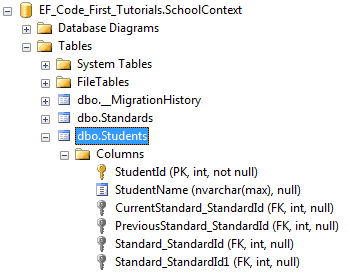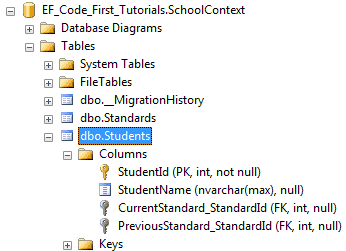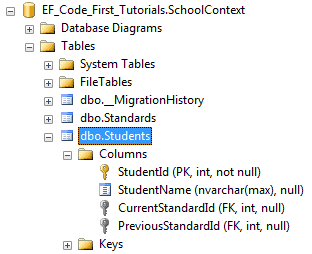Entity Framework Code-First(9.11):DataAnnotations - InverseProperty Attribute
DataAnnotations - InverseProperty Attribute:
We have seen in the Code-First Convention section that Code-First creates {Class Name}_{Primary Key} foreign key column if you have not included foreign key property in a parent class. The InverseProperty attribute is used when you have multiple relationships between classes.
Consider the following example.
public class Student
{
public Student()
{ }
public int StudentID { get; set; }
public string StudentName { get; set; } public Standard CurrentStandard { get; set; }
public Standard PreviousStandard { get; set; }
} public class Standard
{
public Standard()
{ }
public int StandardId { get; set; }
public string StandardName { get; set; } public ICollection<Student> CurrentStudents { get; set; }
public ICollection<Student> PreviousStudents { get; set; } }
As you can see in the above example, Student class includes two navigation properties to Standard class. The same way Standard class includes two collection navigation properties for Student. Code-First creates four columns for this relationship, as shown below.

InverseProperty overrides this convention and specifies alignment of the properties. The following example uses InverseProperty in Standard class to fix this problem.
public class Student
{
public Student()
{ }
public int StudentID { get; set; }
public string StudentName { get; set; } public Standard CurrentStandard { get; set; }
public Standard PreviousStandard { get; set; }
} public class Standard
{
public Standard()
{ }
public int StandardId { get; set; }
public string StandardName { get; set; } [InverseProperty("CurrentStandard")]
public ICollection<Student> CurrentStudents { get; set; } [InverseProperty("PreviousStandard")]
public ICollection<Student> PreviousStudents { get; set; } }
As you can see in the above example, we have applied InverseProperty attribute to CurrentStudents & PreviousStudents property and specify which reference property of Student class it belongs to. Now, Code-First will create only two foreign key column in Student table as shown below.

You can also use ForeignKey attribute to include foreign key property with different name as shown below.
public class Student
{
public Student()
{ }
public int StudentID { get; set; }
public string StudentName { get; set; } public int CurrentStandardId { get; set; }
public int PreviousStandardId { get; set; } [ForeignKey("CurrentStandardId")]
public Standard CurrentStandard { get; set; } [ForeignKey("PreviousStandardId")]
public Standard PreviousStandard { get; set; }
} public class Standard
{
public Standard()
{ }
public int StandardId { get; set; }
public string StandardName { get; set; } [InverseProperty("CurrentStandard")]
public ICollection<Student> CurrentStudents { get; set; } [InverseProperty("PreviousStandard")]
public ICollection<Student> PreviousStudents { get; set; } }
The above example will create the following columns.

Thus, you can use InverseProperty and ForeignKey attribute for multiple relationships between the same classes.
Entity Framework Code-First(9.11):DataAnnotations - InverseProperty Attribute的更多相关文章
- Entity Framework Code-First(9.6):DataAnnotations - StringLength Attribute
DataAnnotations - StringLength Attribute: StringLength attribute can be applied to a string type pro ...
- Entity Framework Code-First(9.5):DataAnnotations - MaxLength Attribute
DataAnnotations - MaxLength Attribute: MaxLength attribute can be applied to a string or array type ...
- Entity Framework Code-First(9.10):DataAnnotations - NotMapped Attribute
DataAnnotations - NotMapped Attribute: NotMapped attribute can be applied to properties of a class. ...
- Entity Framework Code-First(9.9):DataAnnotations - ForeignKey Attribute
DataAnnotations - ForeignKey Attribute: ForeignKey attribute can be applied to properties of a class ...
- Entity Framework Code-First(9.8):DataAnnotations - Column Attribute
DataAnnotations - Column Attribute: Column attribute can be applied to properties of a class. Defaul ...
- Entity Framework Code-First(9.7):DataAnnotations - Table Attribute
DataAnnotations - Table Attribute: Table attribute can be applied to a class. Default Code-First con ...
- Entity Framework Code-First(9.2):DataAnnotations - TimeStamp Attribute
DataAnnotations - TimeStamp Attribute: TimeStamp attribute can be applied to only one byte array pro ...
- Entity Framework Code-First(9.1):DataAnnotations - Key Attribute
DataAnnotations - Key Attribute: Key attribute can be applied to properties of a class. Default Code ...
- Entity Framework Code-First(9.4):DataAnnotations - Required Attribute
Required attribute can be applied to a property of a domain class. EF Code-First will create a NOT N ...
随机推荐
- vi/vim滚动屏幕
VIM帮助文档如是说 Q_sc Scrolling CTRL-E N CTRL-E window N lines downwards (default: 1) CTRL-D N CTRL-D wind ...
- mini2440移植uboot 2014.04(一)
最新版的uboot添加了很多新功能,我决定在最新版代码基础上重新移植一遍加深理解. 我修改的代码已经上传到github上,地址:https://github.com/qiaoyuguo/u-boot- ...
- EntityFramework 学习 一 Eager Loading
贪婪加载是指查询一个类型实体的时候同时查询与实体关联的类型 通过Include()方法实现 using (var context = new SchoolDBEntities()) { var stu ...
- Build Antlr4 projects with eclipse java project template.
from:https://shijinglu.wordpress.com/2015/01/22/build-antlr4-projects-with-eclipse-java-project-temp ...
- ajax实现聊天室功能
需求如下: 先死后活. 需求分析,分析思路如图所示: 1.创建数据库 create database chat; create table messages( id int unsigned prim ...
- java:Map借口及其子类
java:Map借口及其子类 Conllection是保存单值最大得父接口(即没有key的数据),那么Map是保存的内容是一对键值的数据,即KEY->VALUE的形式保存,如电话簿等. Map常 ...
- L100
The world’s lightest wireless flying machine lifts off1Circult: cutting the circuitry from copper fo ...
- list dict set comprehension 列表推导式 (字典推导式,集合推导式)
从一个list生成新的list [ word.upper() for word in 'hellO worlD!' ] 简单的语法,如果不用list comprehension, 则要用更长的代码. ...
- Android之setContentView和LayoutInflater
setContentView: 1.常用的构造函数: 1)setContentView(int layoutResID) 2)setContentView(View view) 3)setConten ...
- FFMPEG内存操作(一) avio_reading.c 回调读取数据到内存解析
相关博客列表 : FFMPEG内存操作(一) avio_reading.c 回调读取数据到内存解析 FFMPEG内存操作(二)从内存中读取数及数据格式的转换 FFmpeg内存操作(三)内存转码器 在F ...
